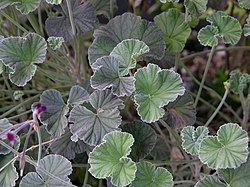Top Qs
Timeline
Chat
Perspective
Pelargonium sidoides
Species of flowering plant From Wikipedia, the free encyclopedia
Remove ads
Pelargonium sidoides is a plant native to South Africa, Eswatini, and Lesotho. Its common names include African geranium and South African geranium.
The current conservation status is Least Concern.[1]
Remove ads
Description
African geranium forms a basal rosette of cordate leaves with a velvet texture and a few short trichomes on long petioles.[2] Its flowers have five dark red to nearly black petals, two of which are sometimes fused. It is often found in flower nearly year-round. It prefers to grow in grasslands with rocky soils. It can be difficult to distinguish from Pelargonium reniforme which grows in a similar area, but tends to have more kidney-shaped leaves.
Remove ads
Uses
In cultivation in the UK, Pelargonium sidoides has received the Royal Horticultural Society's Award of Garden Merit.[3] If grown as a perennial it requires protection in winter, as it does not tolerate temperatures below 5 °C (41 °F). It needs a sunny, sheltered position.
A 2013 Cochrane review found limited to no evidence of benefit with Pelargonium sidoides root extract for the symptoms of acute bronchitis, the common cold and acute rhinosinusitis.[4] A summary of this review found that all studies were "from the same investigator (the manufacturer) and performed in the same region (Ukraine and Russia)."[4]
Root extract of Pelargonium sidoides may be sold as a dietary supplement or traditional medicine under various brand names, but there is no high-quality clinical evidence that it provides any therapeutic effect.[5]
- Pelargonium as groundcover
Remove ads
References
Wikiwand - on
Seamless Wikipedia browsing. On steroids.
Remove ads



